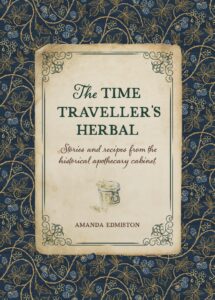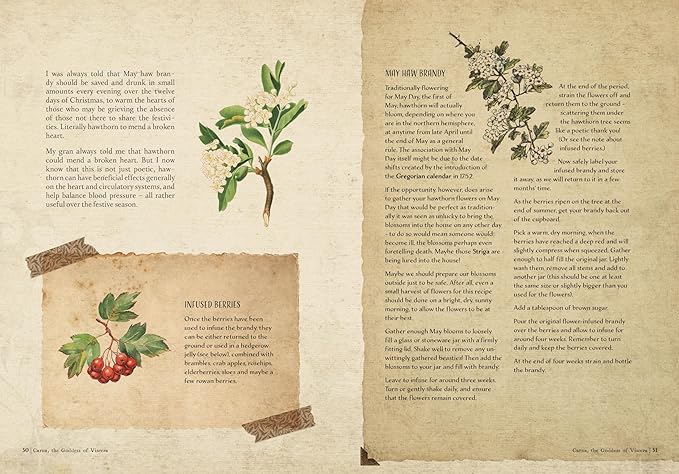Step into the time slip with herbal storyteller Amanda Edmiston, Botanica Fabula as we enter the world of The Time Traveller’s Herbal.
The herbalist has had many names throughout the ages — cunning woman, wise woman, witch?
All hiding the truth of what they are: early pioneers of science, and fountains of traditional knowledge. The Time Traveller’s Herbal is an invitation to step into the spiral of history and discover the stories, folklore and herbal remedies that vitally weave their way through the fabric of our world.
We will start further back, if you care to join me on the full journey held within the book, but for now, for this short moment lets fall into one moment from the time spiral, I’m going to take you back to 200AD and a world of meadow phantoms.
Many of my stories, the recipes and tastes that accompany them, originate in the places I walk. I stop, take a moment, sit and look around me, I start to notice the plants and the changes afforded by time, both seasonal change and historical. I think about the history of the place, the changes that have occurred and the folklore associated with the plants that grow there.
It is easy to be drawn into a spiral if you sit and think, feeling the ground beneath your feet, looking at the unchanging elements, the river and the geography.
One of the places I frequent most is a wild floodplain meadow. It lies behind a castle, where two rivers meet, near to my home in Scotland and this fascinating and ecologically important site often ventures into my stories.
As I walk, I often imagine inviting a small group of friendly folks to travel back into this meadow’s past with me and explore the plants it nurtures and the stories it tells.
So, I’d like to now invite you to visualise it and imagine travelling into it with me, as we move onward into our next swathe of time.

The places we are passing through are barely recognisable without their architectural constructs: the castle and paths that are familiar features in our own time. The tree line is present but is now sculpted differently. Where larch now grows, there is suddenly more oak, the tunnel of blackthorn, seems to be a constant but in this time it stretches further, with young saplings replacing the ancient twisted forms we are familiar with in our time, the branches no longer curtailed by mechanical pruning.
Some things are more than familiar, the arc and curve of the rivers and the contours of the hills and mountains. There may be slight changes, but they are invisible, their journey follows a different pace to ours and so they appear to be a constant, assuring us of geographical certainty, a sense of place.
We find ourselves on the rocky outcrop above the meeting of the two rivers, a confluence marking out the meadow, the shadow where the castle will stand is behind us, but there is a bustling Pictish village on the opposite bank.
We walk towards the flower-strewn field.
Before we reach the meadow, the scent of salicylates beckons. It has a faintly medicinal allure, partially sweet notes, partially antiseptic.
As we reach the first dip down towards the river, the creamy clouds of flowers seem to be blurring the view of the bank, as if some ethereal queen was hiding behind them, not wanting anyone to catch her in her natural form.
I step closer, brushing past the blooms, scattering petals as I seek to catch the thing, the being, I thought I’d seen… but there’s nothing there.
The river ripples with the tremble of something silvery slipping away downstream, eyes maybe watching from the nearby wood. There is a young bullock grazing the clover on the other side of the water, but there is no shimmering regal figure.
My imagination has clearly been seduced by the Queen of the Meadows, flower-led into fantasising phantoms sitting on the shore, or maybe I’m running a temperature?
I check myself for fever, then add a few heads of the meadowsweet (Filipendula ulmaria) to the flask of hot water I carry whenever I remember.
As I sip, the memory of a story whispers in my ear, the penny drops, we are in the presence of the Morrigan, phantom queen, capable of transformation, shapeshifter, one of the ethereal, rarely acknowledged, middle feminine figures in Celtic mythology.
The story goes that the warrior Cu Chulainn was sent to Skye to learn the art of combat from the warrior maid, Sgathaich, as in those days, it is said that only a man could teach a woman to fight and only a woman could teach a man. He became enamoured with her daughter, Uathach, and the pair became betrothed.
But his life was violent, he was a man of temper and as a warrior he was frequently off on battles. His heroic journeys, we sense, are littered with dubious encounters with women and I’m not sure his behaviour was admirable. Certainly the story I was told many years ago suggested he was not an innocent party when he encountered the mighty Morrigan, phantom queen, during a battle at a ford in the form of a beautiful young woman and she offered to help him in the battle if he gave her his love.
When he rebuffed her, claiming his heart belonged to Uathach, she transformed into an eel and tried to twist round his ankles as he crossed the water. But he reached down and wrenched her off, injuring her as he did so. But she was not to be so easily defeated. Next, she took the form of a huge grey wolf, terrifying a herd of cattle and caused them to stampede at the warrior. Taking his slingshot, he hit her hard, wounding her badly in the leg.
Finally, she became a white heifer running at the front of the stampede, right towards Cu Chulainn, but taking a spear he injured her one last time and she vanished, haar-like into the river.
As the battle ends, Cu Chullainn, weary, cut and bruised makes his way along the riverbank, praying that this will not be the night he meets the Bean nighe washing his armour, or hear the cry of the folkloric Caointeach predicting his death.
Eventually he does encounter an old woman, not washing winding cloths or armour but milking a deer, her body marked with familiar injuries, those he had inflicted on the eel, the wolf and the heifer.
Sore and thirsty, he stops and asks her for a drink and blesses her when she gives him a cup and with each repeated cup she gives him, he blesses her again. With each blessing her injuries heal and as the words leave his lips for the third time he realises who she is.
She gives him meadowsweet as a gift and although some say he regrets healing her… we are sure he carries it on his belt from that day forth.
Relying on it, as she has taught him, to bathe in; a handful of fresh blossoms, or a palmful of dried flower heads encased in a muslin bag, added to a bath, to heal his wounds, reduce his fevers and cool him when his temper flares.
We think for a moment on these creamy stems from the flower, called crios Chu-chulainn (Chu-chulainn’s belt) in Gaelic, once also referred to as bride-wort for its popularity as a floral confetti and start to imagine recipes that we can use as the legendary hero once did.
Soothing bath
Meadowsweet blossoms can be added to a bath as the water runs, in a muslin (or similar) bag, to help reduce fevers, oats can also be added to help soothe irritated or inflamed skin.
Just add three of four fresh or dried flowers to the bag and add to the bath as the water runs.
As with many of the plants I mention meadowsweet can be put into a cup and steeped in freshly boiled water for three or four minutes to create a herbal tisane, meadowsweet is a valuable remedy having mildly pain relieving properties and really good at soothing indigestion!
We know we are not here for long, this is a shadow of a place an ancient time glimpsed as we travel, spiralling to a place where we can stop for a moment, but giving a nod to the last of the mist as it dissipates and the sun lifts a little higher in the early morning sky, we gather an armful of meadowsweet and carry it with us as to later steep it in water, add honey and turn it into a cordial, fit for a queen.
A cordial for a phantom queen to ease tempers, fevers and heartburn*
30 heads of meadowsweet blossoms in full flower.
Juice of one unwaxed freshly squeezed lemon and a little grated rind.
300 grams of blossom honey (locally produced has additional benefits).
1 litre of filtered water.
Bring the water to the boil and then dissolve half the honey into it, when the honey has dispersed add the meadowsweet and lemon juice and rind and allow to simmer for a further three minutes.
Remove from heat and rest overnight (or at least for an hour or two), to allow the meadowsweet to infuse.
Strain and then add the rest of the honey and return to the boil, allowing to simmer for a further five minutes or so to reduce.
The mixture should take on the consistency of a cordial, more honey can be added as desired.
Bottle in sterile glass jars or kilner style bottles. Lasts for up to 3 months if kept cool.
Mix with still or sparkling water or maybe a sparkling wine and feel the heat dissipate.
A remedy with which to maybe start your own historical apothecary’s cabinet, maybe inspiring you to join me on the rest of my herbal storytelling journey through time.
Because we sense that twist in time, the feeling of being pulled into a tide of years ebbing and flowing, the shift is visceral…
If you want to continue your journey with Amanda, you can find The Time Traveller’s Herbal in all good bookshops and on the website.
* FolkloreThursday takes no responsibility for folklore practices listed on the website, and information is provided for entertainment only. FolkloreThursday does not offer medical advice, and recommends that you consult a medical professional before trying out any remedies or practices listed on the website.



